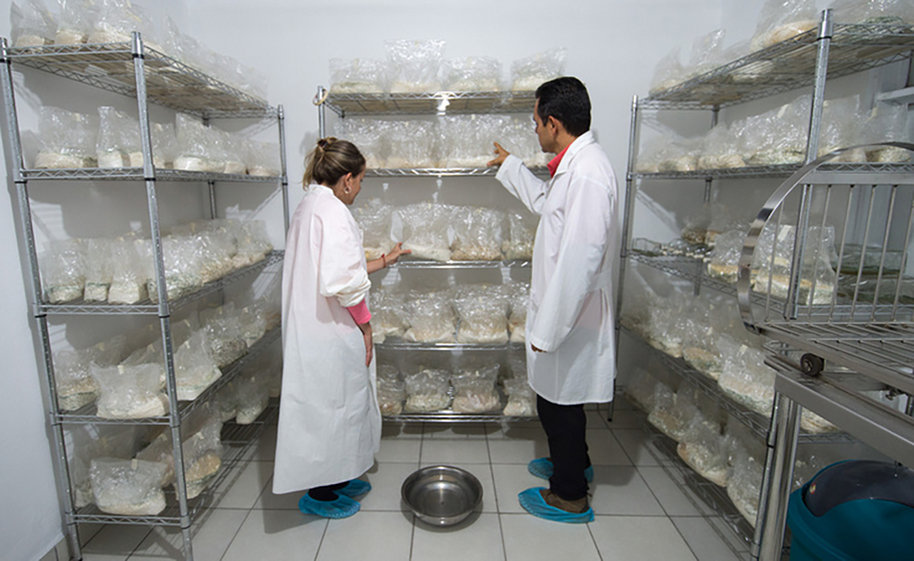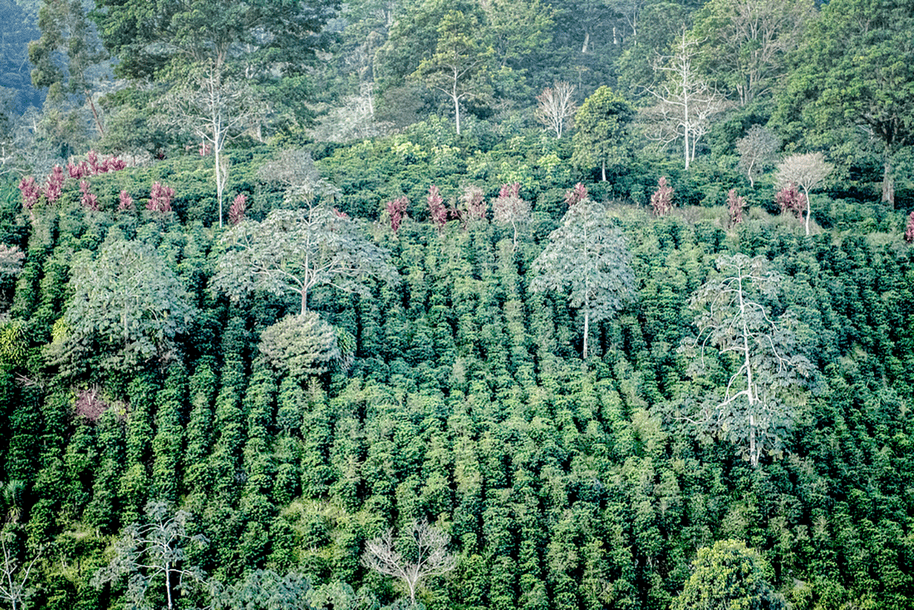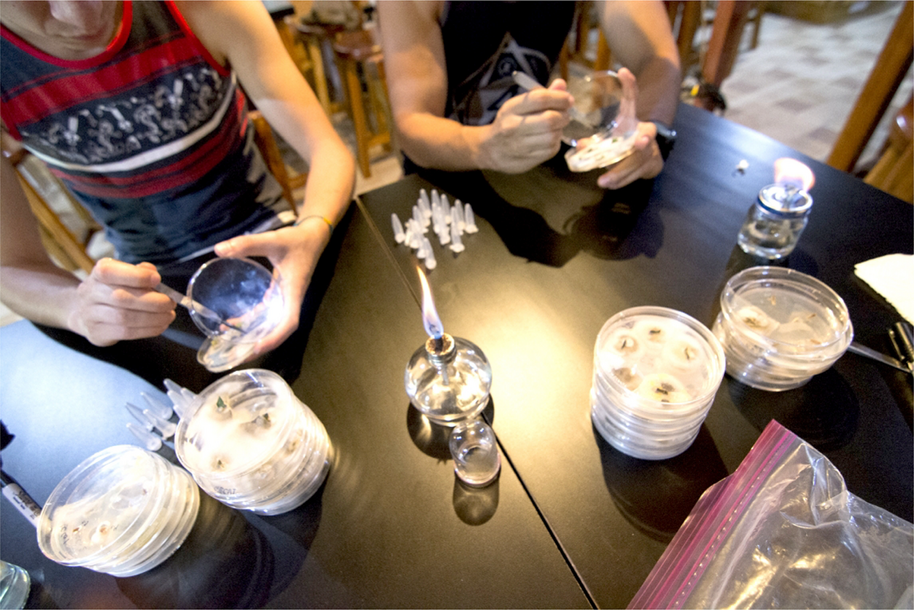Farming Practices, Fungal Endophytes, and Coffee
Understanding How Agroforestry and Organic Farming Affect Foliar Endophytes in Costa Rican Coffee

Nestled in the country’s lush, verdant mountains, Costa Rica’s coffee farms produce some of the best beans in the world.
Fungal endophytes are an important partner in coffee production. These symbiotic fungi live in plant tissues and can help plants fight off disease, tolerate stress, and grow.
A recent study published in Agrosystems, Geosciences & Environment evaluated the endophytic communities found in Costa Rican coffee plants grown under different management strategies.
Nestled in the country’s lush, verdant mountains, Costa Rica’s coffee farms produce some of the best beans in the world.
Relative to its land size—smaller than the state of West Virginia—the country is home to a lot of coffee production. “But it’s not enough to compete against Brazil or Indonesia or a country that produces a lot and has a lot of area,” says Priscila Chaverri, a mycologist at Bowie State University in Bowie, MD. And its economic role in the country has waned over the years, she says.
“But it’s still very important part of our culture,” Chaverri explains of coffee farming. “And Costa Rican coffee is considered some of the best quality‐wise in the world. … Even though we don’t produce a lot, what we produce is super high quality.”
Most production happens on small farms that are grouped into cooperatives that provide training and share equipment and other resources among its members. As producers in Costa Rica become more interested in implementing agroforestry and organic methods, Chaverri and colleagues have been studying how these practices affect an important partner in coffee production: fungal endophytes.
These symbiotic fungi live in plant tissues and can help plants fight off disease, tolerate stress, and grow. In a recent study published in Agrosystems, Geosciences & Environment, Chaverri and her co‐authors evaluated the endophytic communities found in Costa Rican coffee plants grown under different management strategies (https://doi.org/10.1002/agg2.20476).

Sampling for Function and Ecology
Like the human body, plants too contain multitudes. “Almost every space in between cells is filled with endophytes. That could be fungi, there could be bacteria, maybe even viruses. Some may be good, some may be bad, or they could just be doing nothing there,” Chaverri explains. Some could be latent pathogens that flare up with physiological changes in the plant while some could have protective functions, producing secondary metabolites or chemical compounds that actually fight off pathogens themselves. Their roles are essential and numerous, but how agriculture affects fungal endophytes in particular is poorly understood.
Comprehensive studies of fungal endophytes typically focus on alpha diversity, a measurement of how many species are in the sample. When comparing organic and non‐organic farming practices, alpha diversity only tells one part of the story, Chaverri says. “Even though they might have the same amount of species, what are the actual identities, the taxonomy of these different groups?”
She and her colleagues use high‐throughput sequencing to identify and extrapolate the functions and ecology of the fungi they obtained. “Could they have the potential to control pathogens in the coffee? Could they be benefitting … the roots? Or could they be pathogens that are waiting for the plant to become stressed and actually cause disease?”

For their study in Agrosystems, Geosciences & Environment, Chaverri and her co‐authors worked with farms in two locations in Costa Rica: Coto Brus and Los Santos, which have similar environmental conditions but slightly different geographies. “One is very close to the border with Panama, and the other one is kind of in the middle of this mountain range,” Chaverri explains of the two areas, respectively.
The researchers focused on three coffee varieties from two different production sites: Caturra, from the organic farm Hacienda La Amistad in Coto Brus, and Catuaí and Obatá, from a conventional farm cooperative CoopeTarrazú in Los Santos. The team chose these sites because their management practices are well documented and verifiable for research purposes. “We know exactly what they were adding, and we knew they were definitely organic,” Chaverri explains of Hacienda La Amistad. For the conventional farm, “they want to convert to organic, but they’re not yet there, so we also know what they’re adding,” she continues.
The researchers sampled healthy leaves from each variety from plots growing in both sunlight and in shade provided by other plants. Then back in the laboratory, they isolated and analyzed the fungal colonies within and dove a layer deeper to identify their ecologies and possible activities within the plants’ leaves.
Differences Between Farming Practices and Sun Regimes
Across the resulting fungal communities, the researchers found significant differences between coffee leaves from the two different farming systems. “Maybe conventional had more species,” Chaverri says. “But when you go into the specifics, the actual names and potential function they have, then you have more of those beneficial endophytes in the organic farming,” she says.
Coffee from the organic farm yielded more putative plant pathogens, but also more mycoparasites. “You have more things, for example, like mycoparasites or fungi that are attacking other fungi,” Chaverri explains. “The difference is that you have the natural enemies there.” The organic leaves also contained more saprotrophs that process decaying wood and nectar, pointing to the possibility of more flowers and plant diversity in that location, she says, while leaves from the conventional farming system had more plant litter saprotrophs.
The researchers also uncovered differences between the different sun regimes. “That’s important because at least in Costa Rica, for example, most of the coffee is produced under shade,” Chaverri says. Plant pathogens, soil saprotrophs, and animal parasites were more prevalent in the sun‐exposed leaves, while shaded plants had more mycoparasites, litter saprotrophs, and ectomycorrhizal and sooty molds. “With the shaded plantation, there were less endophytes with the potential to become pathogens,” she continues. In an agroforestry scenario, the abundance of other plants that are providing ample shade could be acting as barriers to other pathogens, Chaverri says, pointing to the practice’s potential benefits.
Coffee variety, however, didn’t exert much of a difference—location was more important. “In some ways, we expected that because if you look at other studies, they mention that actually the environment plays a more important role in shaping microbial communities than the genetics,” Chaverri explains. More research is needed to understand coffee variety’s impact on endophyte diversity, the researchers say.

Taking Results from the Lab to the Farm
This study is part of a larger project of Chaverri’s. “OK, we have all this diversity. If we find all these different beneficial fungi that are maybe controlling pathogens in these coffee plants, from those fungi we can select some that we can actually do experiments with live plants and then take them to the plantations,” she says.
She’s collected fungi from wild relatives of coffee, characterized them, and performed in vitro tests to see how they behave when grown in Petri dishes with pathogens.
“If the beneficial fungus, or the endophyte, reduces the growth of the pathogen, then we measure that. Now we have to take it to the plant,” she says. “Of course, the next step is to take this to a plantation [and] let the seedlings grow to see how these beneficial effects last through the years,” she continues. “With coffee farmers … they’re going to say, ‘I want to see it in my plantation.’”
In other studies, Chaverri has identified endophytic species of Trichoderma fungi, incorporated them into coffee plant seedlings, and then exposed them to disease to see their effect (https://doi.org/10.1093/jambio/lxad090). She’s found they reduced damping off, a fungal condition that rots the plant at the soil line, in the seedlings. The researchers incorporated these Trichoderma isolates into a biofungicide product that can be given to farmers for use in their operations.
For farms like CoopeTarrazú that are interested in shifting their management systems and incorporating more organic management practices, the results from the study can guide those decisions. The bottom line for farmers? Saving money and producing more beans, Chaverri says.
“If they have a lot of diseases, then they’re going to be spending a lot on agrochemicals. If they lose plants to disease, they produce less beans.”
Dig Deeper
Check out the research cited in this article Castillo-González, H., Bloomberg, J., Alvarado-Picado, E., Yarwood, S., & Chaverri, P. (2024). Agricultural practices influence foliar endo- phytic communities in coffee plants of different varieties. Agrosystems, Geosciences & Environment, 7, e20476. https://doi.org/10.1002/agg2.20476
Text © . The authors. CC BY-NC-ND 4.0. Except where otherwise noted, images are subject to copyright. Any reuse without express permission from the copyright owner is prohibited.










